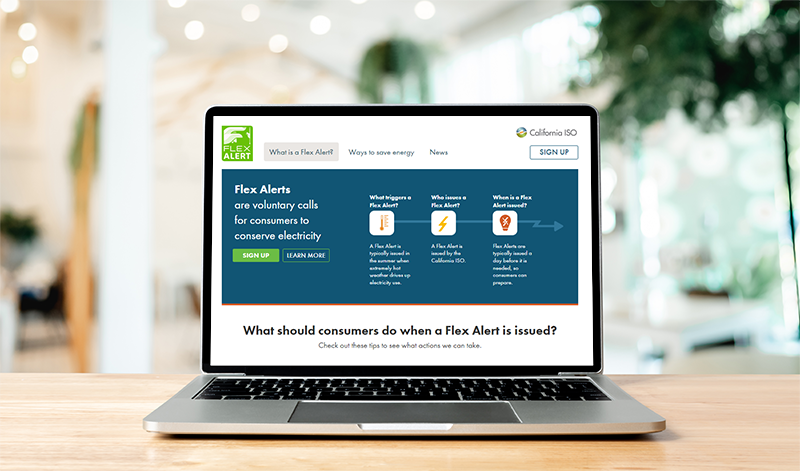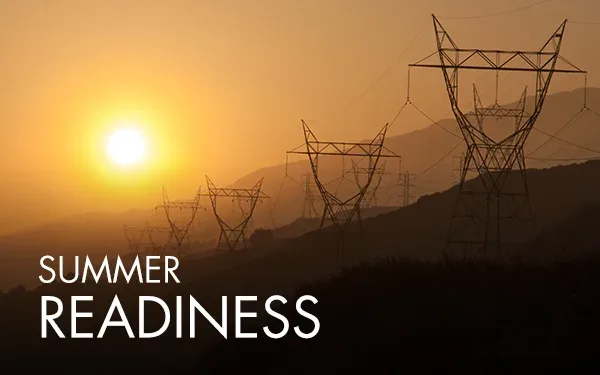Ready for summer? We spent the winter getting prepared
During even the coldest and wettest days of winter, the California Independent System Operator (ISO) was intently focused on the hottest days of the year. High and prolonged heat, combined with wildfires and drought, has put increased strain on the grid in recent years, especially in the evenings, when temperatures remain hot and solar production rolls off the system.
During the past three summers, the power grid was buffeted by climate change impacts bearing down quicker and stronger than expected: in August 2020, extreme, prolonged heat across much of the West led to the first rotating power outages in almost 20 years; the Bootleg Fire in July 2021 took out transmission pathways serving our grid, bringing it perilously close to rotating outages; and a 10-day heat wave in August and September of 2022 again created severe electricity shortages and a call for utilities to prepare for outages on the most challenging day of the event.
Some of these events created outcomes that were never dreamed of, much less realized in practice. After each incident, we took serious stock of not only grid resilience, but our organization’s performance, identifying and applying lessons learned in the areas of operations, policy, and communications.
In 2020 and 2021, we thoroughly inspected and made refinements to our market design, strengthened coordination with state agencies, neighboring balancing authorities and diverse stakeholders, and improved our communication channels both internally and with the news media and public.
After the long, grueling heat wave of September 2022, we continued to evolve, creating and tightening communication protocols within our organization and with grid operators in other western states, utilities, regulators and state agencies.
As we do every year, we released our 2023 Summer Loads and Resources Assessment in May, which shows that the grid is in a better position going into this summer compared to 2022, thanks to much-improved hydro conditions within California and significant amounts of new capacity, including 3,000 megawatts (MW) of battery storage. We are expecting to have about 8,500 MW of new nameplate capacity on the system by early September 2023 compared to last September. This impressive level of resource development is testament to the hard work and focus of the California Public Utilities Commission, the California Energy Commission, other state agencies, load serving entities and resource developers within California. We are grateful for the enhanced coordination and teamwork that has made this level of resource development possible.
At the same time, the grid remains vulnerable to widespread extreme heat, especially in the evening hours later in the summer. What we have learned is that it’s the combination of circumstances that we cannot predict, like the location of wildfires, extreme heat, and resource outages that create residual risk for the grid.

Recognizing that grid reliability is a shared regional responsibility, the California ISO hosted its 3rd annual virtual Summer Readiness Leadership Roundtable in May to discuss the outlook for summer operations. Senior executives from more than 30 utilities and other entities in California and across the West met to outline the supply-and-demand picture and anticipated weather and grid conditions for this coming summer. Again, while conditions are improved over last year, the participants understood the need for continued communication and coordination across the West to help us all get through extreme weather and other reliability challenges.
The operations team, along with the Reliability Coordinator (RC West), neighboring balancing areas, load-serving entities and participants in the Western Energy Imbalance Market across our regional footprint participated in a series of tabletop exercises to ensure effective communication and coordination during emergencies. Another workshop was conducted with the Governor’s Office and other state agencies to be sure emergency protocols are in synch across state agencies.
Our Communications and Public Relations team has also been meeting regularly with their counterparts in the Governor’s office, state agencies and the utilities to enhance their coordination, and these meetings will become more frequent with the onset of summer.
With the high-voltage electricity transmission system squarely in the spotlight during the intense heat of summer, our communications team has also refined and expanded information gathering and delivery to the news media and public. We understand the importance of transparency, data-sharing and educating consumers about how power gets to their homes and businesses and how they can help balance the grid by conserving energy when conditions are stressed.
There are multiple ways for the public to learn how to prepare for grid stress and track electric system conditions, especially in hot weather or other extreme events:
FlexAlert.org – The California ISO declares a Flex Alert when operators see a potential for supply shortages. By conserving electricity during a Flex Alert, which is usually called a day before it takes effect, consumers can help reduce stress on the grid and avert rotating power outages. The website has been redesigned to align with the California Public Utilities Commission’s outreach campaign to build awareness and momentum for the voluntary conservation program. It contains updated tips, translations for Spanish and Vietnamese, and a way to sign up for text or email notifications when a Flex Alert is called

We’ve also refreshed the logos and banners for use on websites or in media coverage to help spread the word about the benefits of conserving when a Flex Alert is called.
- Our News webpage on caiso.com is a central hub for Summer 2023 information and activities. On that page, viewers will find our 2023 Summer Loads and Resources Assessment, the Joint Agency Summer Energy Reliability Outlook Media Briefing, fact sheets on summer-related topics, news releases, and images and B-roll video of the ISO headquarters and control center. The page also has a link to sign up for news releases, Daily Briefings, and other communication channels.
- The News page is also home to the California ISO’s System Conditions Bulletin which gets activated during grid events. The bulletin is a direct line of communication from our grid operators on changing conditions, and will include relevant data points, emergency declarations, and links to helpful resources. We’ll alert the public via our social media channels whenever there’s an updated bulletin.
- Follow us on Twitter (@California_ISO), Facebook, and LinkedIn for breaking news.
- To monitor grid conditions in real time, follow Today’s Outlook on our website, and download the ISO Today mobile app.
The California ISO is charged with delivering energy across high-voltage, long-distance transmission wires that serve 28 million utility customers in roughly 80 percent of the state and a small portion of Nevada. We are also proud to serve customers in 11 western states through our real-time energy market, the Western Energy Imbalance Market (WEIM).
We collaborate with a broad range of partners to keep the grid in top shape, but we also are committed to prepare for any eventuality, such as a fire or heat wave threatening the transmission network. We will continue to coordinate, plan, and test our systems to help keep the power flowing without interruption when the next extreme event occurs.


